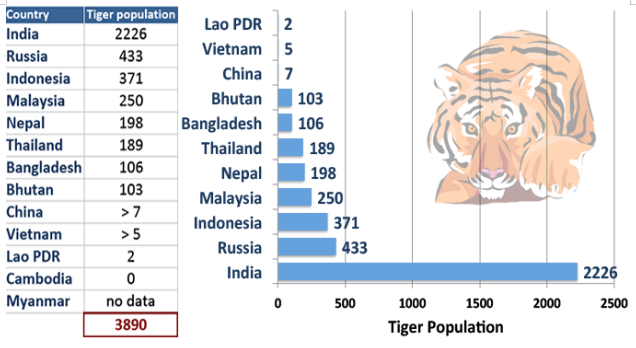- Courses
- GS Full Course 1 Year
- GS Full Course 2 Year
- GS Full Course 3 Year
- GS Full Course Till Selection
- Online Program
- GS Recorded Course
- NCERT (Recorded 500+ Hours)
- Polity Recorded Course
- Geography Recorded Course
- Economy Recorded Course
- AMAC Recorded Course
- Modern India, Post Independence & World History
- Environment Recoded Course
- Governance Recoded Course
- Science & Tech. Recoded Course
- International Relations and Internal Security Recorded Course
- Disaster Management Module Course
- Ethics Recoded Course
- Essay Recoded Course
- Current Affairs Recoded Course
- CSAT
- 5 LAYERED ARJUNA Mentorship
- Public Administration Optional
- ABOUT US
- OUR TOPPERS
- TEST SERIES
- FREE STUDY MATERIAL
- VIDEOS
- CONTACT US
Global Tiger Numbers Rise Southeast Asia Faces Habitat Threats
Global Tiger Numbers Rise Southeast Asia Faces Habitat Threats
15-11-2023

Why in News?
Tiger population numbers from 2010-2022 were submitted to Global Tiger Recovery Program (GTRP) and Convention on International Trade in Endangered Species (CITES) under GTRP 2.0, aiming for tiger conservation from 2023-2034.
- The 2010 St Petersburg Declaration committed 13 tiger range countries to reverse the species' decline and double their numbers by 2022.
Status of Tiger Conservation in World?
- Wild tiger status is good in South Asia and Russia, but Southeast Asia faces challenges in global tiger population recovery.
- The tiger population has grown by 60%, reaching 5,870.
- Tiger populations in Southeast Asian Tiger Range Countries (TRCs) are declining, with countries like Bhutan, Myanmar, Cambodia, Lao-PDR, and Vietnam experiencing a "grim" situation.
- Effective habitat conservation and protection measures have contributed to the success of countries in South Asia, including Bangladesh, Bhutan, India, Nepal, China, and Russia in North East Asia.
- In 2022, India's wild tiger population stood at 3,167, while Nepal has tripled its population.

Global Tiger Recovery Program 2.0 (2023-34)
- The Minister of Foreign Affairs of the Royal Government of Bhutan released GTRP 2.0 at Thimphu on International Tiger Day,29 July,2023.
- The World Bank initiated GTRP in 2010 under the Global Tiger Initiative (GTI) to double wild tiger populations by 2022, with Tiger Range Countries (TRCs) committing to its implementation.
- The Global Tiger Forum (GTF) was established as the primary implementation arm for the tiger agenda.
- Tiger range countries have formed GTRP 2.0 through the Global Tiger Forum's intergovernmental platform, collaborating with organizations like the Worldwide Fund for Nature.
- GTRP 2.0 focuses on enhancing tiger governance, resource allocation, and protection, while addressing contemporary issues like Human-Wildlife Conflict.
- The updated version incorporates both existing and new actions to adopt a more comprehensive approach to safeguarding endangered wild tigers.
Threads to the Tiger Population in the World
- Prey and Tiger Poaching: The region faces challenges due to widespread prey and tiger poaching, inadequate patrolling, poor wildlife monitoring, forest loss, proximity to trade hubs, and rapid infrastructure development.
- Low Investment in Wildlife Conservation: The decline in tiger populations can be attributed to inadequate monitoring and insufficient investment in wildlife conservation.
- Habitat Loss and Fragmentation: Tiger conservation is threatened by habitat loss, fragmentation, and biodiversity depletion due to anthropogenic factors.
- The report highlights the significant loss of forests across their ranges, particularly in Southeast Asia, as a rapid decline factor.
- Degradation of Tiger Habitat: Tiger habitat degradation due to deforestation, infrastructure development, and illegal logging is highlighted in a report, emphasizing the need for prey population augmentation in certain areas.
Suggestions Given by the Report
- Need of Genetically Viable Tiger Population: The report emphasized the need to address habitat loss, prey depletion, and tiger poaching to ensure a viable tiger population.
- The lack of action on tiger stressors could lead to the loss of a significant portion of the tiger population in Southeast Asia and parts of South Asia.
- Address Human-environmental Stress in Tiger Landscapes:
The Tiger Conservation Landscapes (TCL) should be viewed from the perspective of an ongoing human-environmental stress continuum.
- Human-induced modifications in TCLs, including agro-pastoral practices, affect welfare factors for wild herbivores, affecting their abundance, including the tiger.
- Need a Robust Policy Action: The dire situation necessitates a robust policy framework, as the population's long-term resource availability has increased by 60%, reaching 5,870 individuals.
- The report underscores the severe threats and challenges faced by tigers, particularly in Southeast Asia, which is currently facing a dire situation.
Initiatives Taken for Tiger Conservation
-
At Global Stage:
- St. Petersburg Declaration on Tiger Conservation: This resolution was adopted In November 2010, by the leaders of 13 tiger range countries (TRCs) assembled at an International Tiger Forum in St. Petersburg, Russia
- 13 TRCs include Bangladesh, Bhutan, Cambodia, China, India, Indonesia, Laos, Malaysia, Myanmar, Nepal, Russia, Thailand, and Vietnam.
- The Global Tiger Recovery Program aims to increase wild tigers' population from 3,200 to over 7,000 by 2022.
-
Global Tiger Forum:
- The GTF, an intergovernmental international body based in New Delhi, India, is the only entity with members from all willing countries collaborating on a global Tiger protection campaign.
- The organization was established following the recommendations of an international symposium on Tiger Conservation held in New Delhi, India.
- Seven of the 13 tiger range countries, including Bangladesh, Bhutan, Cambodia, India, Myanmar, Nepal, and Vietnam, are currently members of the Global Tiger Threat (GTF).
-
Global Tiger Initiative (GTI):
- GTI, launched in 2008 by the World Bank, GEF, Smithsonian Institution, Save the Tiger Fund, and International Tiger Coalition, represents over 40 non-government organizations.
- The Global Tiger Initiative (GTI), a global coalition of 13 tiger range countries, aims to save wild tigers from extinction through collaboration with governments, international organizations, and civil society.
-
In India:
- Project Tiger
- National Tiger Conservation Authority
- Tiger Census in India
- Wild Life (Protection) Amendment Act, 2022
Conclusion
The global tiger population is increasing, but Southeast Asian tigers face challenges that require immediate attention and comprehensive conservation strategies.



